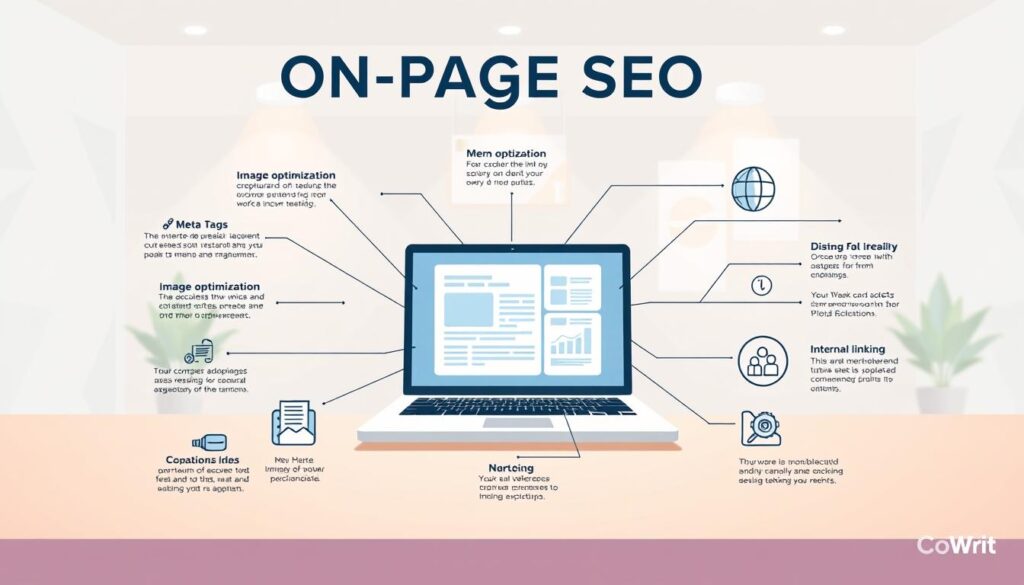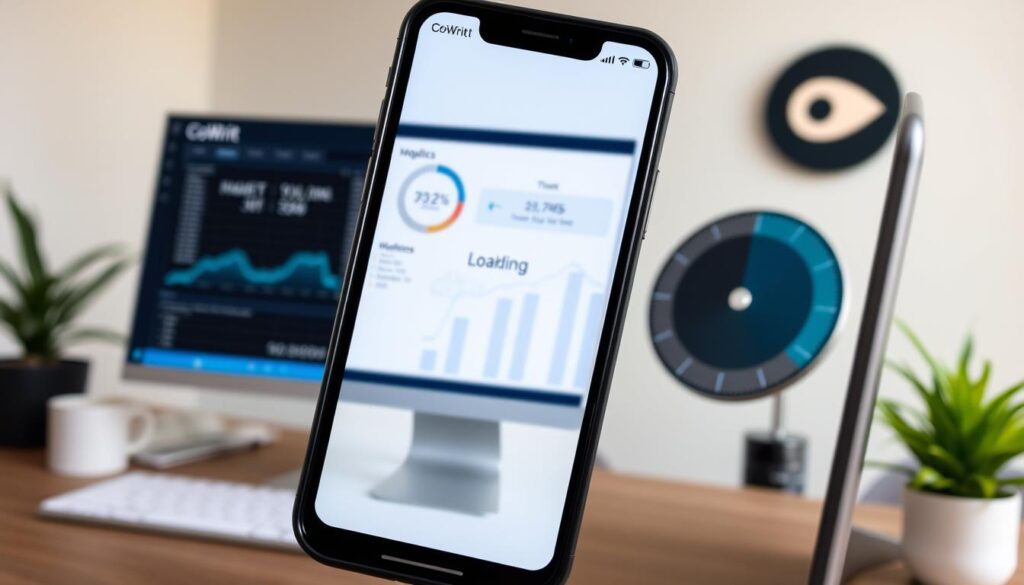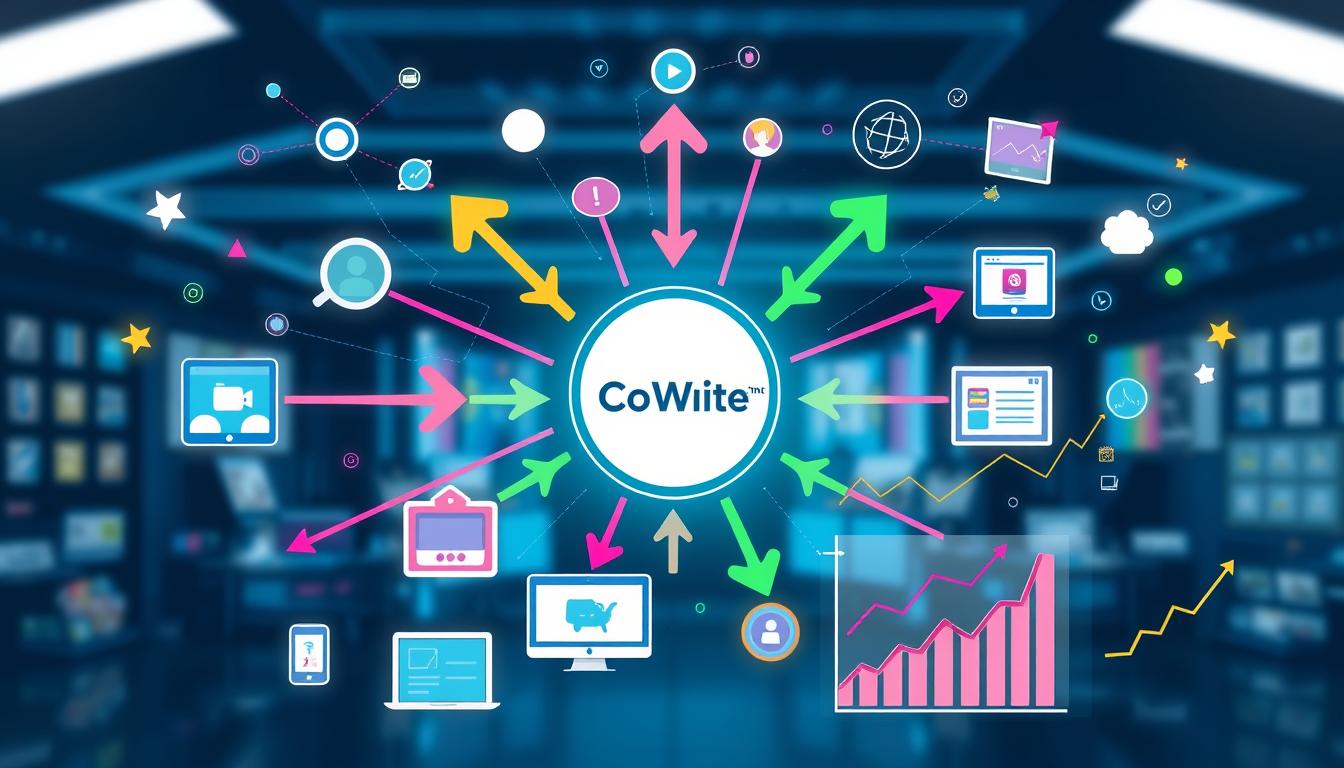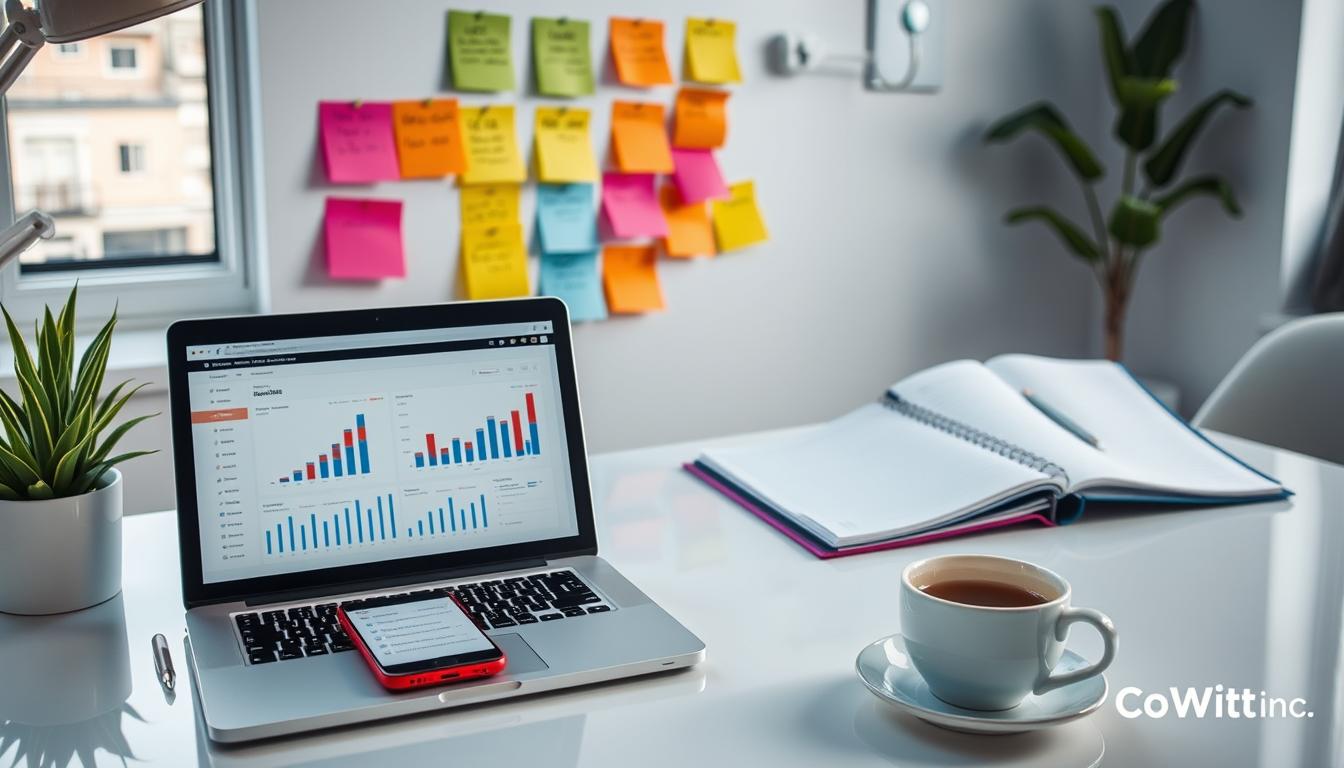Are you looking to boost your online presence? Optimizing your website content for search engines is key to improving visibility and driving more traffic to your site.
By following SEO best practices, you can boost your website’s ranking on search engine results pages (SERPs). This attracts more customers. A well-optimized site is easier for search engines to find, helping users discover you online.
To start, consider working with a professional content writing team. You can reach out to us via WhatsApp Call or Chat at +44-7822-010953 or +44-7874-424345 (USA Support Available). This can help improve your website’s SEO.
Key Takeaways
- Optimizing your website content is vital for SEO success.
- Implementing SEO best practices can improve your website’s visibility.
- A well-optimized website attracts more customers.
- Partnering with a content writing team can enhance your SEO efforts.
- Boosting online presence requires ongoing SEO optimization.
Understanding SEO and Its Importance
For businesses aiming to succeed online, knowing SEO basics is key. We’ll explore what SEO is and why it’s vital for your business.
What is SEO?
SEO stands for Search Engine Optimization. It’s about making your website more visible in search results. This includes keyword research, on-page optimization, and link building. By optimizing your site, you can attract more visitors and possibly increase sales.
Why SEO Matters for Your Business
SEO can greatly impact your business’s online presence. By ranking higher on search engines like Google, you can reach more people. Here’s why SEO is important:
- Increased online visibility
- Targeted traffic to your website
- Improved brand credibility
- Competitive advantage
| SEO Benefit | Description | Impact on Business |
|---|---|---|
| Increased Visibility | Higher rankings on search engines | More people see your brand |
| Targeted Traffic | Attracting the right audience | More conversions |
| Brand Credibility | Building trust with your audience | More loyal customers |
By focusing on Google ranking factors and using search engine optimization techniques, you can improve your site’s performance. This will attract more qualified leads to your business.
Keyword Research: The Foundation of Optimization
Keyword research is key to SEO. It shows what your audience is looking for. By finding the right keywords, you can make your website content match what people search for. This boosts your site’s visibility in search results.
Identifying Relevant Keywords
To find good keywords, know what your audience searches for. Start by making a list of terms linked to your business or niche. Think about what your customers might search for when looking for your products or services.
Tips for Effective Keyword Identification:
- Use keyword research tools to analyze search volume and competition.
- Consider long-tail keywords for more specific search queries.
- Analyze your competitors’ keyword strategies.
Tools for Keyword Research
Many tools can help with keyword research. Google Keyword Planner, Ahrefs, SEMrush, and Moz Keyword Explorer are popular ones. They give insights into search volume, keyword difficulty, and related keywords. This helps you choose the best keywords for your strategy.
Comparison of Keyword Research Tools:
| Tool | Key Features | Cost |
|---|---|---|
| Google Keyword Planner | Search volume data, keyword suggestions | Free |
| Ahrefs | Keyword analysis, backlink analysis, content analysis | Paid |
| SEMrush | Technical SEO audit, competitor analysis, keyword research | Paid |
Using these tools and methods, you can build a strong keyword research strategy. This boosts your SEO and brings more targeted traffic to your site.
Creating Quality Content That Ranks
To rank higher in search engines, you need to create content that is both high-quality and engaging. This means understanding what your audience wants and delivering it in a way that’s informative and fun.
Importance of Originality
Original content is key for improving search engine visibility. Search engines like Google favor unique content that adds value to users. Content that’s not original can lead to penalties, hurting your website’s ranking.
To ensure originality, focus on:
- Conducting thorough research to provide fresh insights.
- Avoiding duplication by using plagiarism detection tools.
- Creating content that reflects your brand’s voice and perspective.

Engaging Your Audience
Engaging your audience is just as important as creating original content. Your content should connect with your readers, making them want to stay longer and interact with your website.
To engage your audience effectively:
- Use a friendly and approachable tone.
- Incorporate storytelling techniques to make your content more relatable.
- Use visuals like images and videos to break up the text and enhance understanding.
A well-structured content strategy can significantly boost your website’s SEO. Here’s a comparison of key content strategies:
| Content Strategy | SEO Impact | Audience Engagement |
|---|---|---|
| Original and Informative | High | High |
| Duplicate or Low-Quality | Low | Low |
| Engaging with Visuals | Medium | High |
By focusing on creating SEO-friendly website content that is both original and engaging, you can improve your website’s search engine ranking and provide a better experience for your users.
On-Page Optimization Techniques
On-page optimization is key to a good SEO strategy. It helps your website rank higher in search engines. By optimizing each web page, you can make your site more visible and attract more visitors.

Title Tags and Meta Descriptions
Title tags and meta descriptions are essential for on-page optimization. Your title tag should be short, clear, and include your main keyword. For example, “Best SEO Practices for Small Businesses” tells users what the page is about.
Your meta description should give a brief summary of the page. It should be enticing enough to make users click from search results.
- Keep your title tag under 60 characters to avoid being cut off in search results.
- Your meta description should be around 155-160 characters, with your target keywords included naturally.
Header Tags and Content Structure
Header tags (H1, H2, H3, etc.) are vital for organizing your content. They help highlight important points for both users and search engines. Your content should have a clear hierarchy, starting with one H1 tag per page, followed by H2 and H3 tags as needed.
Here’s how you can use header tags effectively:
- H1 Tag: The main title of the page, like “On-Page SEO Techniques.”
- H2 Tags: Subheadings, such as “Keyword Research” and “Optimizing Content.”
- H3 Tags: Sub-subheadings for more details, like “Long-Tail Keywords” and “Content Originality.”
Internal Linking Strategies
Internal linking is a powerful technique for on-page optimization. It helps search engines understand your site’s structure and content hierarchy. By linking to relevant pages, you improve user experience and help search engines crawl and index your site better.
Here are some best practices for internal linking:
- Link to content that is relevant and related to your site.
- Use descriptive anchor text for your links, avoiding generic text like “click here.”
- Avoid over-linking; focus on quality over quantity.
By mastering these on-page optimization techniques, you can greatly improve your website’s SEO performance. This will drive more targeted traffic to your site.
Utilizing Long-Tail Keywords Effectively
Using long-tail keywords is a key part of a good SEO plan. These keywords are more specific and have lower search numbers. This makes it easier to rank for them. By adding these keywords to your content, you can draw in more targeted traffic that’s likely to convert.
Benefits of Long-Tail Keywords
Long-tail keywords have many benefits for businesses wanting to boost their SEO. One big plus is less competition. Because they’re more specific, there are fewer searches. This means you have a better chance of ranking higher in search results.
Another advantage is higher conversion rates. Long-tail keywords target users looking for something specific. These users are more likely to find what they need on your site, boosting your conversion chances.
| Benefits | Description |
|---|---|
| Reduced Competition | Less competition for specific phrases |
| Higher Conversion Rates | Targeted traffic is more likely to convert |
| Improved Relevance | Better matches for user search queries |
How to Incorporate Them
To add long-tail keywords to your content, you need a smart plan. First, do thorough keyword research to find good long-tail keywords. Use tools like Google Keyword Planner or Ahrefs to find keywords with decent search volume and low competition.
After finding your long-tail keywords, add them naturally to your content. Use them in title tags, meta descriptions, headings, and body content. But don’t overdo it, as keyword stuffing can harm your rankings.

- Use long-tail keywords in subheadings to organize your content.
- Put them in your meta descriptions to get more clicks.
- Optimize your images by using long-tail keywords in alt tags and file names.
By smartly using long-tail keywords, you can make your site more visible. This drives more targeted traffic and boosts your SEO performance.
Enhancing User Experience for SEO
When you optimize your website for search engines, remember to focus on user experience. A site that’s easy to use and search engine friendly can boost your online presence a lot.
Mobile optimization is key for a better user experience. Most people use mobile devices to surf the web. So, your site must work well on all devices.
Importance of Mobile Optimization
A site that works well on mobiles is not just good for users. It also helps your site show up better in search results. Search engines like Google give mobile-friendly sites a boost in rankings.
- Make sure your site is responsive.
- Check how your site looks on different mobiles.
- Make images and content load fast on mobile.
Page Load Speed Considerations
Page load speed is another big deal for user experience. A slow site can make people leave quickly. Try to keep your site fast, under three seconds.

To speed up your site, optimize images and use browser caching. Also, cut down on heavy scripts. These SEO best practices will make your site faster and better for users.
By working on mobile optimization and page speed, you’ll make a site that ranks well and is great for users.
Utilizing Multimedia for Better Engagement
Multimedia content, like images and videos, can really boost your site’s user experience. Adding these elements makes your content more fun and interesting for your audience.
Benefits of Images and Videos
Images and videos bring many benefits to your website. They can:
- Break up text and make content easier to read
- Make your website look better
- Help explain complex ideas
- Get users more involved and interested
For example, a great image can grab the reader’s attention and keep them reading. Videos can offer a deeper experience, making your content stick in their minds.

Optimizing Multimedia for SEO
To maximize your multimedia content’s impact, optimize it for SEO. Here are some tips:
- Use descriptive file names: When saving images or videos, use names that include your key words.
- Add alt tags and descriptions: Alt tags help search engines understand your images, while descriptions add more context.
- Optimize video content: Use transcripts and closed captions to make your videos more accessible and boost their SEO.
By following these tips, your multimedia content will not only engage users but also rank better in search engines. This improves your SEO-friendly website content and on-page SEO strategies.
Leveraging Social Media for SEO
To make your website more visible, it’s key to know how social media and SEO work together. Using social media can bring more people to your site. This helps improve your search rankings.
How Social Media Impacts Rankings
Social media can really help your SEO by making you more visible online. When you post content, it can lead to more site visits. This can boost your search rankings. Also, likes and shares show search engines your content is good and relevant.
Key factors to consider:
- Content sharing and its impact on traffic
- Social signals as indicators of content quality
- Brand mentions and their effect on credibility
A study shows social media signals and search rankings are closely linked. An SEO expert said, “Social media is not just about being social; it’s about being visible and relevant in a crowded digital landscape.”
“The most important thing in communication is hearing what isn’t said.” – Peter Drucker
This quote shows how important it is to understand social media’s role in SEO. Knowing these dynamics helps you make your online presence stronger.
Best Practices for Sharing Content
To use social media well for SEO, follow some key sharing practices. Here are some tips:
| Platform | Content Type | Best Time to Post |
|---|---|---|
| Engaging visuals, videos | Afternoon, evening | |
| Short, informative posts | Peak hours (12 pm – 3 pm) | |
| High-quality visuals, stories | Evening, during leisure hours |
Knowing each platform’s strengths helps you share better content. This boosts your social media presence and SEO.
Remember, the key to successful social media SEO is consistency and engagement.
Monitoring and Analyzing Your SEO Efforts
Understanding how your SEO efforts are doing is key. You need to watch your performance closely. This way, you can spot what needs work and make smart choices to get better.
Tools for Tracking SEO Performance
To keep an eye on your SEO, you need the right tools. Some top tools include:
- Google Analytics: Gives you insights into your site’s traffic, how people engage, and sales.
- SEMrush: Does deep SEO audits, tracks keywords, and looks at what your competitors are doing.
- Ahrefs: Excels in analyzing backlinks and finding keywords.
These tools show you how your content is doing and where you can do better.
Adjusting Strategies Based on Data
After you get the data, it’s time to make changes. Tweaking your SEO based on what you learn is key to getting better. Here’s what to do:
- Check your keyword performance: See which keywords bring in visitors and adjust your content.
- Look at your on-page SEO: Make sure your title tags, meta descriptions, and header tags match your keywords.
- Boost your content quality: Use data to see what your audience likes and make more of it.
By watching your SEO and tweaking it based on data, you can get more people to visit your site.
- Keep your content fresh and relevant by updating it often.
- Use long-tail keywords to target specific searches.
- Make your website load faster to improve user experience.
Staying Current with SEO Trends
To keep your search engine rankings high, it’s key to know the latest SEO trends. Search algorithms change often, and keeping up with these changes is vital for better visibility.
Algorithm Evolution
Search algorithms have grown smarter, making SEO more complex. Now, focus on making high-quality content that users love and follows SEO rules.
Growing Importance of Local SEO
Local SEO is getting more critical, mainly for businesses with a physical spot. By making your site better for local searches, you can get more local customers.
Keeping up with SEO trends and adjusting your plans helps you stay ahead. This way, you can succeed in search engine rankings for the long haul.



